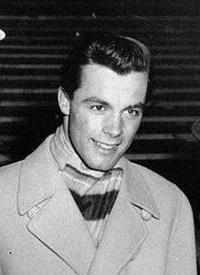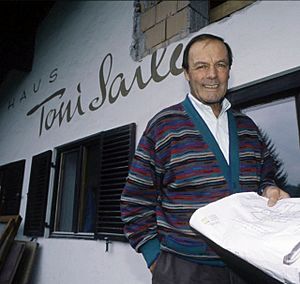Toni Sailer facts for kids
| Alpine skier | |||||||||||||||||||||||||||||||||||||||||||||||

Sailer in 1956
|
|||||||||||||||||||||||||||||||||||||||||||||||
| Disciplines | Downhill, Giant Slalom, Slalom, Combined |
||||||||||||||||||||||||||||||||||||||||||||||
|---|---|---|---|---|---|---|---|---|---|---|---|---|---|---|---|---|---|---|---|---|---|---|---|---|---|---|---|---|---|---|---|---|---|---|---|---|---|---|---|---|---|---|---|---|---|---|---|
| Club | Kitzbühel Ski Club | ||||||||||||||||||||||||||||||||||||||||||||||
| Born | 17 November 1935 Kitzbühel, Tyrol, Austria |
||||||||||||||||||||||||||||||||||||||||||||||
| Died | 24 August 2009 (aged 73) Innsbruck, Tyrol, Austria |
||||||||||||||||||||||||||||||||||||||||||||||
| Height | 1.83 m (6 ft 0 in) | ||||||||||||||||||||||||||||||||||||||||||||||
| Retired | 1959 (age 23) | ||||||||||||||||||||||||||||||||||||||||||||||
| Olympics | |||||||||||||||||||||||||||||||||||||||||||||||
| Teams | 1 – (1956) | ||||||||||||||||||||||||||||||||||||||||||||||
| Medals | 3 (3 gold) | ||||||||||||||||||||||||||||||||||||||||||||||
| World Championships | |||||||||||||||||||||||||||||||||||||||||||||||
| Teams | 3 – (1954, 1956, 1958) | ||||||||||||||||||||||||||||||||||||||||||||||
| Medals | 8 (7 gold) | ||||||||||||||||||||||||||||||||||||||||||||||
|
Medal record
|
|||||||||||||||||||||||||||||||||||||||||||||||
Anton Engelbert "Toni" Sailer (born November 17, 1935 – died August 24, 2009) was an amazing alpine ski racer from Austria. Many people think he was one of the best skiers ever!
When he was just 20 years old, Toni won all three gold medals in alpine skiing at the 1956 Winter Olympics. This was a huge achievement! He almost did it again at the 1958 World Championships, winning two gold medals and one silver. He also won world titles in a special event called the combined race in both those years.
Contents
Toni Sailer's Skiing Career
Toni Sailer was born and grew up in Kitzbühel, a town in Tyrol, Austria. People often called him "Blitz from Kitz." "Blitz" is a German word that means "lightning" or "flash," showing how fast he was!
Even as a teenager, Toni was incredibly talented. In 1952, at only 16, he won the downhill and combined races at a big event in Megève. He broke his leg in 1953, which made him miss that season. It also affected his performance at the 1954 World Championships.
But Toni came back strong in 1955. The next year, in 1956, he made history. He became the first person to win gold medals in all three alpine skiing events at the Olympics: the downhill, slalom, and giant slalom. He won these races by a lot of time – 3.5, 4.2, and 6.2 seconds, respectively! He was the fifth athlete ever to win three gold medals at the same Olympic Games. Toni was the most successful athlete at the 1956 Winter Olympics. The Super-G event, another ski race, didn't even exist until the 1980s. It was added to the Olympics in 1988. As of 2014, Toni Sailer was still the youngest male skier to win a gold medal in Olympic alpine skiing.
From 1948 to 1980, the Olympic alpine ski events were also counted as FIS World Championships. This meant that if you won an Olympic gold, you were also a world champion. The combined event was changed after 1948 to make room for the giant slalom in 1950. For many years (from 1952 to 1984), no Olympic medals were given for the combined event. However, it was still an FIS world championship from 1954 to 1980. During this time, the combined event was a "paper" race. This meant they used the results from the other three races to figure out who won the combined. A separate combined event returned to the World Championships in 1982 and to the Olympics in 1988. This new combined event included one run of downhill and two runs of slalom.
Two years after his amazing 1956 Olympics, Toni Sailer won three more gold medals and one silver at the 1958 World Championships in Bad Gastein, Austria. He won five out of six possible Olympic/World Championship races. He almost had a perfect record, but he got a silver medal in the Bad Gastein slalom race, just seven-tenths of a second behind the winner. Toni also won the combined event again, giving him a total of seven world titles in just two years! He stopped competing in ski racing in 1959. This was because there were some questions about whether he was still an amateur athlete after he started acting in movies.
Life After Ski Racing
After he stopped racing, Toni Sailer got involved in many different businesses. He worked with ski clothing and equipment. He even helped with the first successful fiberglass skis, which were made in Montreal, Quebec, Canada.
From 1957 to 1971, Toni appeared in a few movies. Most of these were lighthearted comedies, often set in snowy mountain areas. This allowed him to show off his amazing skiing skills on screen. Later, from 1972 to 1976, he was the main coach and technical director for the Austrian Skiing Association (ÖSV). In the 1960s and 1970s, he ran a summer ski camp at Whistler in western Canada. He also sang professionally for a while and released 18 music albums! Sometimes, even as late as 2003, he appeared in TV shows or movies made for TV.
In January 2004, Toni Sailer said he would run for Mayor of Kitzbühel. However, he changed his mind a few weeks later. He realized that being mayor was a full-time job, and he couldn't commit to it. In 2006, he announced he was retiring as the "chief of race" for the Hahnenkamm Race. He had held that important position for 20 years.
Awards and Honors
Toni Sailer received many awards for his incredible achievements:
- He was named Austrian Sportspersonality of the year in 1956, 1957, and 1958.
- In 1999, he was honored as the "Austrian Sportspersonality of the Century."
- On September 16, 1958, he was featured on the cover of Bravo magazine.
- The International Olympic Committee gave him the Olympic Order in 1985. This award recognizes people who have made great contributions to the Olympic movement.
Toni Sailer's Family Life
Toni Sailer married Gaby Rummeny in 1976 in Vancouver. Sadly, she passed away from cancer in 2000. He married his second wife, Hedwig Fischer, in 2006. She was with him until he passed away. Toni also had a son named Florian with Gaby.
His Passing
In January 2008, it was announced that Toni Sailer had laryngeal cancer, a type of throat cancer. He had been getting treatment for it for several months. He passed away from cancer in Innsbruck in 2009, at the age of 73. He was buried in his hometown of Kitzbühel. His funeral ceremonies took place near the finish line of the famous Hahnenkamm Race.
Movies Toni Sailer Appeared In
- A Piece of Heaven (1957)
- A Thousand Stars Aglitter (1959)
- Twelve Girls and One Man (1959)
- Kauf dir einen bunten Luftballon (1961)
- Sein bester Freund (1962)
- Sansone e il tesoro degli Incas (1964)
- Ski Fever (1966)
- Aunt Trude from Buxtehude (1971)
- Holidays in Tyrol (1971)
- Wenn das die Nachbarn wüßten (1991)
- Almenrausch und Pulverschnee (1993, TV series)
See also
 In Spanish: Toni Sailer para niños
In Spanish: Toni Sailer para niños


